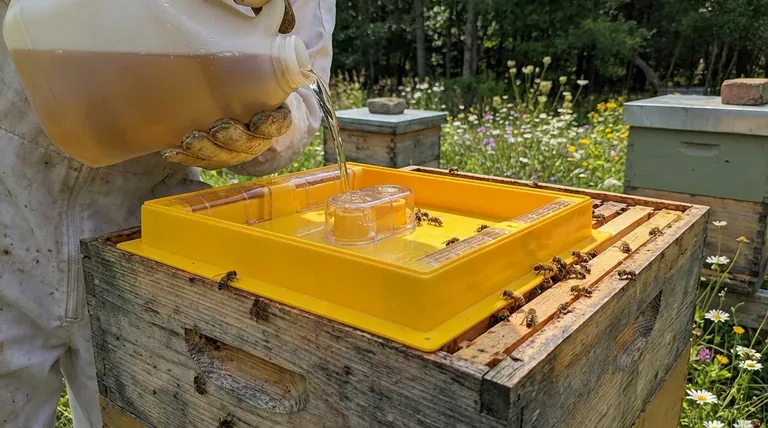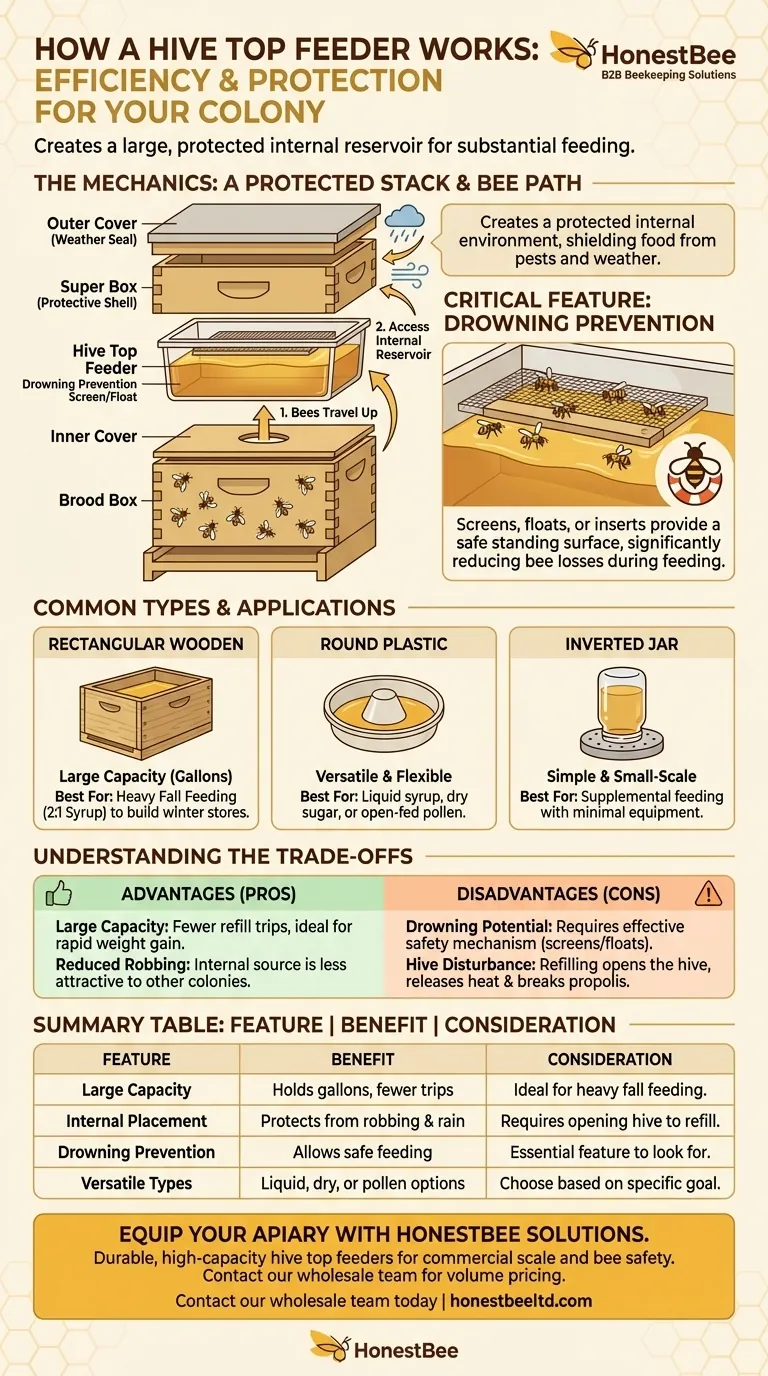In short, a hive top feeder works by creating an internal, protected reservoir of food that sits directly on top of the uppermost hive box. Bees travel up from the brood nest through a hole in the hive's inner cover to access the syrup or feed, which is contained within the feeder and protected from the elements by an outer cover.
The core principle behind a hive top feeder is to provide a large volume of food with minimal exposure to outside pests or weather. This design makes it a highly effective tool for substantial feeding periods, such as preparing a colony for winter.

How a Hive Top Feeder Functions
A hive top feeder is an external attachment, but its design makes the food source an internal part of the hive's protected environment. This is achieved through a specific and deliberate stacking order.
The Standard Hive Assembly
To use a hive top feeder, you first place the inner cover on top of the uppermost hive box. The feeder itself then rests directly on top of this inner cover, positioned over the central hole.
An empty hive box, or "super," is placed around the feeder. This creates a protective shell, shielding the feeder from rain and wind.
Finally, the hive's main outer cover is placed on top of this empty box, sealing the entire assembly from the elements and preventing access by robbing insects.
The Bee's Path to the Syrup
Bees in the colony access the food by traveling up from the top brood box and through the hole in the inner cover.
This path leads them directly into the feeder's reservoir. From here, they can access the syrup at whatever level it has been filled to.
Preventing Drowning
A critical design feature of any quality hive top feeder is a mechanism to prevent bees from drowning in the liquid feed.
This is often accomplished with a screen top or a plastic insert that floats or sits within the syrup. These additions provide a surface for the bees to stand on while they consume the food, dramatically reducing losses.
Common Types and Their Applications
While the principle is the same, different styles of hive top feeders are suited for different beekeeping goals and scales.
The Rectangular Wooden Feeder
This is a very common style, often holding several gallons of syrup. Its large capacity makes it ideal for feeding heavy 2:1 sugar syrup in the fall to build up winter stores.
The Round Plastic Feeder
Round feeders are often more versatile. They can be used with an insert for liquid feeding or used without the top for providing dry pollen or sugar. They can even be placed in an empty hive box within the bee yard for open feeding accessible to all colonies.
The Inverted Jar Feeder
A simpler version involves an inverted jar, such as a mason jar, with small holes punched in the lid. The jar is placed directly over the hole in the inner cover, allowing syrup to drip down for the bees to consume.
Understanding the Trade-offs
Like any piece of beekeeping equipment, hive top feeders have clear benefits but also potential downsides that require careful management.
Advantage: Large Capacity
Their ability to hold gallons of syrup at once means fewer trips to the apiary. This is crucial during fall feeding when the goal is to add significant weight to the hive quickly.
Advantage: Reduced Robbing
Because the food source is entirely contained within the hive structure, it is far less likely to attract robbing bees from other colonies compared to entrance feeders.
Disadvantage: Potential for Drowning
If the feeder lacks a proper screen, float, or other safety mechanism, a significant number of bees can drown. It is crucial to ensure your feeder is equipped to prevent this.
Disadvantage: Hive Disturbance
Refilling the feeder requires opening the top of the hive. This breaks the propolis seal, releases hive heat, and can be disruptive to the colony, especially in cooler weather.
Making the Right Choice for Your Goal
Selecting a feeding method depends entirely on what you are trying to accomplish for your colony at a specific time of year.
- If your primary focus is heavy fall feeding: The large capacity of a rectangular wooden feeder is the most efficient tool for the job.
- If your primary focus is versatility: A round feeder offers the flexibility to provide liquid syrup, dry sugar, or open-fed pollen.
- If your primary focus is small-scale supplemental feeding: An inverted jar feeder is a simple and effective method that requires minimal specialized equipment.
Ultimately, understanding how a hive top feeder integrates with the hive's structure allows you to support your colony's health and strength through critical seasons.
Summary Table:
| Feature | Benefit | Consideration |
|---|---|---|
| Large Capacity | Holds gallons of syrup; fewer refill trips. | Ideal for heavy fall feeding. |
| Internal Placement | Protects feed from robbing bees and rain. | Requires opening the hive to refill. |
| Drowning Prevention | Screens or floats allow bees to feed safely. | Essential feature to look for. |
| Versatile Types | Options for liquid syrup, dry sugar, or pollen. | Choose based on your specific goal. |
Equip your apiary with the right feeding solutions from HONESTBEE.
As a trusted supplier for commercial apiaries and distributors, we provide durable, high-capacity hive top feeders designed for efficiency and bee safety. Whether you're building winter stores or managing nutrition for multiple colonies, our equipment supports your operation's scale and success.
Contact our wholesale team today to discuss your beekeeping supply needs and volume pricing.
Visual Guide

Related Products
- Professional Hive Top Bee Feeder for Beekeeping
- HONESTBEE Round Hive Top Bee Feeder for Syrup
- Rapid Bee Feeder White Plastic 2L Round Top Feeder for 8 or 10-Frame Bee Hives
- HONESTBEE Professional Hive Top Bee Feeder Feeding Solution
- HONESTBEE Professional Entrance Bee Feeder Hive Nutrition Solution
People Also Ask
- What types of hive boxes is the round hive top feeder compatible with? Universal Fit for 8 & 10-Frame Langstroth Hives
- How is the plywood floor fitted into the hive-top feeder? Ensure Longevity with a Floating Floor Design
- What is a top feeder for bees? Maximize Colony Health with Efficient Feeding
- What are the advantages of hive top feeders? Maximize Feeding Efficiency for Your Apiary
- Do I need an inner cover with a hive top feeder? Optimize Your Hive Setup for Healthy Bees



















